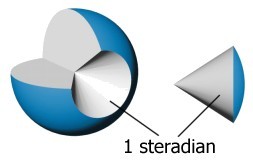
1. What are the units for quantifying light, and the ways of describing our experience of it?
2. How does the visual system arrive at lightness constancy?
3. How do natural constraints in brightness perception relate to the detection of edges?
4. What are convolution and reconstitution?
5. What low-, mid-, and high-level factors contribute to contrast illusions?
6. What is Marr’s two-stage approach?
7. How is the raw primal sketch obtained, and what is the result of this processing?
8. How does this approach make up for the shortcomings in feature-template “theory”?
- the measurement of visible radiation from light sources
Photometric units:
• ________: radiant power from a light source
- unit: lumen = light produced by a standard candle (“candela”, a.k.a. “___________”)
- candela = 1 lumen per steradian (“_______ _______,” or unit of solid angle that is conical in shape)

e.g., 1 lm = 1.46 mW
• ___________: amount of light falling on a surface
- unit: lux = 1 lumen per square metre of area (lm/m2)
e.g., daylight = 10,000 lx, full moon = 0.1 lx, office = 250 lx
• _________: amount of light reflected from a surface
- unit: nit = 1 candela per square metre of area (cd/m2)
e.g., LED monitor = 250 nits, iPhone = 1,000 nitsf
• ___________: proportion of light reflected from a matte (non-glossy) surface
- unit: percent (%) or “albedo” = (luminance/illuminance) × 100
e.g., typically, white paper = 90%, black paper = 10%
• __________: perceptual impression of intensity of light source
• _________: perceptual impression of surface “greyness”; psychological counterpart to reflectance of a surface
illumination |
× |
reflectance |
= |
_______ _________ |
(light falling on a surface) |
(proportion of light reflected from a surface) |
(amount of light on retina) |
Burzlaff (1931):
- presented two sets of 48 grey squares: one by a window (organized by lightness) another in a ___ corner (randomly arranged)
- selected one square from the window set as the standard
- asked observers which comparison square from the dim set matched it
- performance was _________
e.g., standard had 78% reflectance, comparison had 72%
- but standard was under 20× more illumination!
intensity |
reflectance |
amount of light |
|
standard |
200 |
78% |
= 156 |
comparison |
10 |
72% |
= 7 |
- _____ principle: the percentage of light reflected determines perception of lightness
- lightness _________: ability to perceive the true reflectance properties of an object--no matter what the illumination is
Rock (1983):
- consider white and black paper on a partially lit desktop
- the black paper in the light has greater luminance than the white paper in the dark--yet we still maintain lightness constancy!
- is this due to “______ ______”?
- nope: same result obtains for unfamiliar stimuli
The visual system must be able to determine reflectance, despite “contamination” by differences in _________.
- how can we magically filter out all but the correct interpretation?
- by using properties that are generally true of the world
- Land & McCann (1971): _______ theory (retina + cortex), based on two natural constraints:
1. variations in ____________ are gradual within an object--this is typically due to proximity to a light source and does not represent an edge
2. changes in ___________ are abrupt between objects--this is typical of an edge or boundary between different regions or objects
How is lightness detected?
• ___________: matching a certain receptive field (or feature detector) with an image
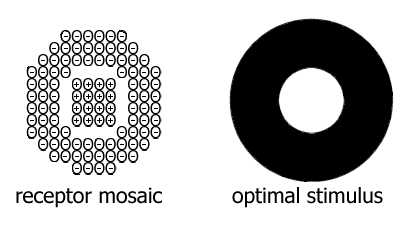
- this does two things: 1. smooths out any noise or small differences in illumination, and 2. detects edges
• feature detectors respond to stimuli:
e.g., move a spot of light across a receptive field:
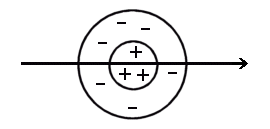
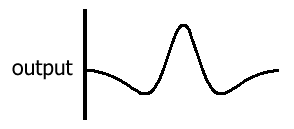
- detector has “_________” the point of light across several positions in the visual field
- if there is a _______ change in luminance, it is not detected as an edge:
stimulus: |
|
luminance profile: |
|
edge detection: |
|
- a gradual change in luminance is not encoded as an ____
- if there is an abrupt change in luminance, it is detected as an edge:
stimulus: |
|
luminance profile: |
|
edge detection: |
|
- abrupt change in luminance is detected as an edge
How are the edges filled in?
• reconstitution (“to construct anew”) via _____________: activity is spread from an edge, smoothing out all small changes in illumination
stimulus: |
|
luminance profile: |
|
edge detection (via convolution): |
|
reconstitution (via deconvolution)
|
|
Unfortunately, the reconstitution process may lead to artefacts, such that our percept is not exactly the same as the original stimulus; this is like reconstituted juice tasting different from fresh-squeezed.
- result in _________ lightness perception (breakdown of lightness constancy)
Simultaneous Contrast:
stimuli: |
|
luminance profile: |
|
edge detection: |
|
reconstitution: |
|
- how does the convolution and deconvolution take place?
Chevreul illusion (1861):
stimulus: |
|
luminance profile: |
|
stimulus: |
|
luminance profile: |
|
processing (_______ __________): |
|
output: |
|
- the above mechanism can explain the effect
- knowing the explanation does not eliminate the effect (not cognitively penetrable)
- ergo, this mechanism is potentially the __________ ____________ underlying the effect
Craik-O’Brien-Cornsweet Effect (COCE):
stimulus: |
|
luminance profile: |
|
edge detection: |
|
reconstitution: |
|
percept: |
|
- this illusion is caused by a “_________________”--the edge is detected, then reconstituted into a percept that doesn’t match the stimulus
- how does the reconstitution/filling-in process work?
- propagation of lateral __________ connections in V1 or V2 is possible (Davey, Maddess, & Srinivasan, 1998)
Problem: exceptions to _______ __________ explanations:
Benary cross (1924):
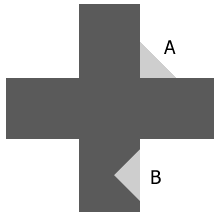
- both triangles should receive equal lateral inhibition, but seem different shades
White’s illusion (1979):
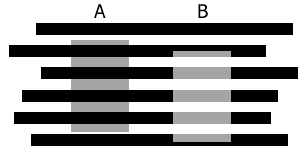
- rectangle A should receive ______ lateral inhibition (and seem lighter), but it seems darker
- rectangle B should receive a ___ of lateral inhibition (and seem darker), but it seems lighter
Solutions:
- explained in terms of “_____________”: appearance of an area is influenced by the surroundings to which it seems to belong (Gilchrist et al., 1999)
- triangle B _______ to the dark cross, which makes it seem lighter in contrast
- rectangle B _______ to the black bars, which makes it seem lighter in contrast
- suggests ______-_____ processing instead of retinal mechanism
Adelson (2000):
- an explanation of lightness perception requires consideration of ________ levels of processing:
• ___-_____ vision: at the retina; includes light adaptation, and centre-surround receptive fields
• ____-_____ vision: cognitive processes; includes knowledge about objects, materials, and scenes
• ___-_____ vision: ill-defined; involves surfaces, contours, grouping, etc.
- low-level models can explain lightness perception for (2-D) “_________” (named for Piet Mondrian, Dutch Neoplasticist painter, 1872-1944)
- but cannot account for a world more complex than Mondrians
e.g., Knill & Kersten’s illusion (1991): both figures contain _________ COCE ramps, but are interpreted very differently

- mid-level explanations: the _______ approach:
e.g., Koffka’s ring (1935): appears uniform

e.g., when split, the rings appear different shades of grey:
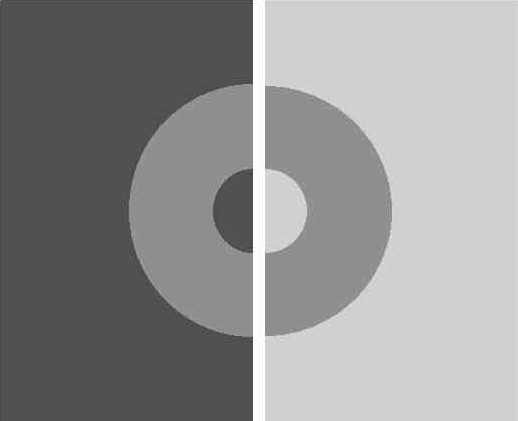
e.g., when shifted, different __________ ____________ occurs:

(spatial configuration affects simultaneous contrast)
- the problem of lightness constancy: luminance image is the product of the ___________ image (due to paint) and the ___________ image (due to illumination/shading)
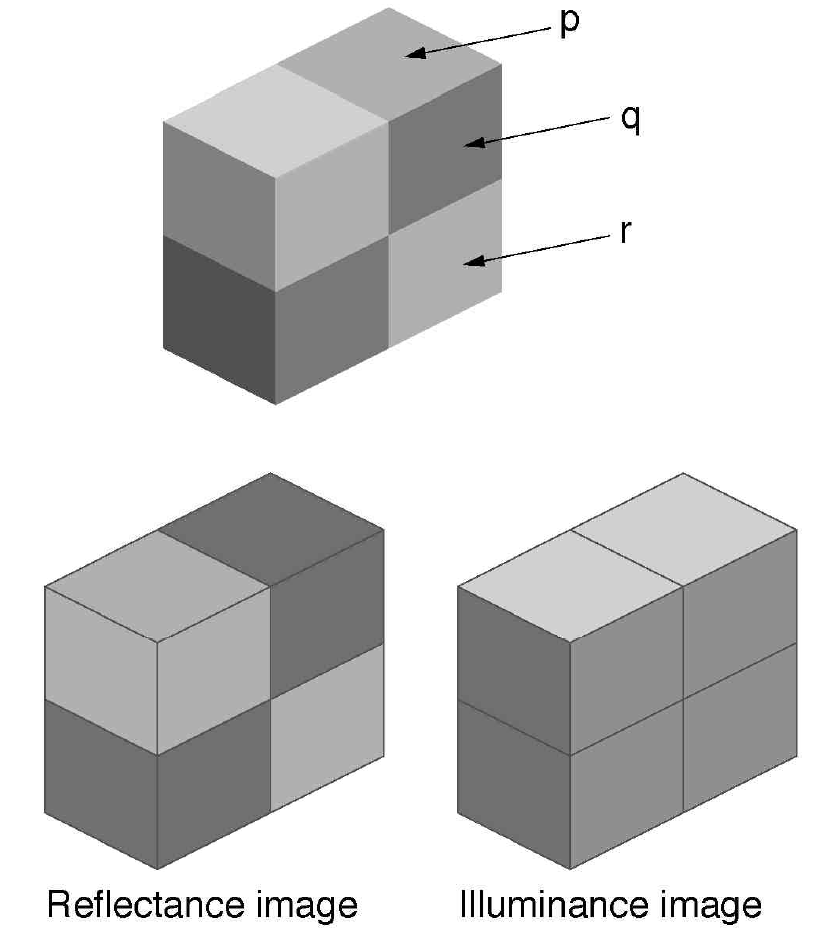
- different _________ (place where two or more contours come together) provide information on reflectance and shading
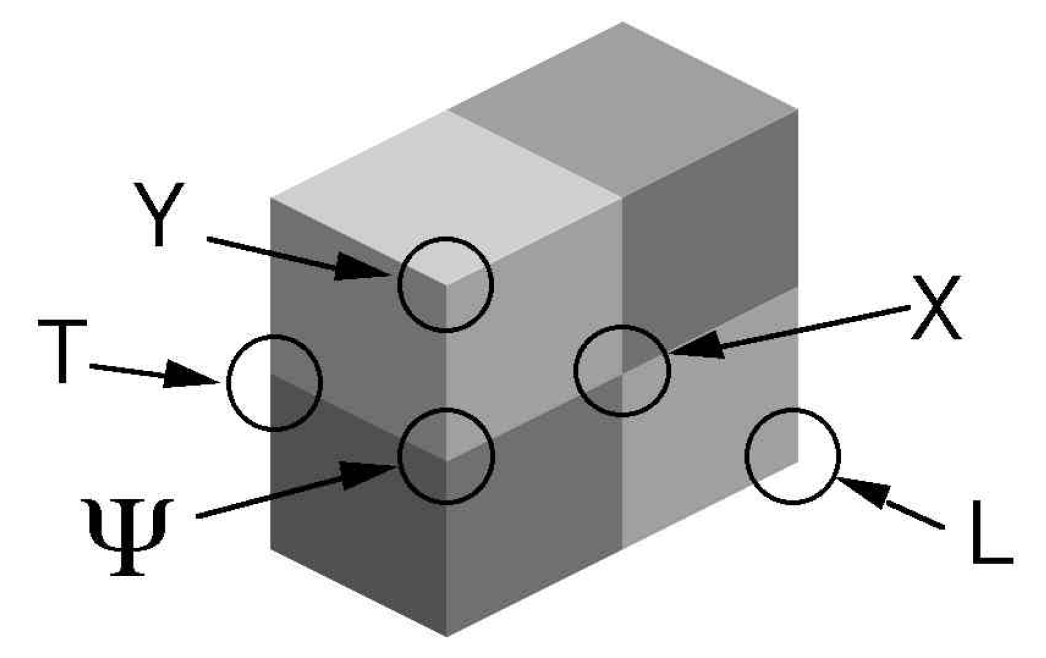
- junction configuration and grey levels forming the junction provides cues about surface shading and reflectance
• Ψ-junctions: vertical spine appears to be a ________ with different illuminances on each side; angled arms appear to represent a reflectance edge that crosses the dihedral
e.g., the __________ _____ depend on Ψ-junctions:
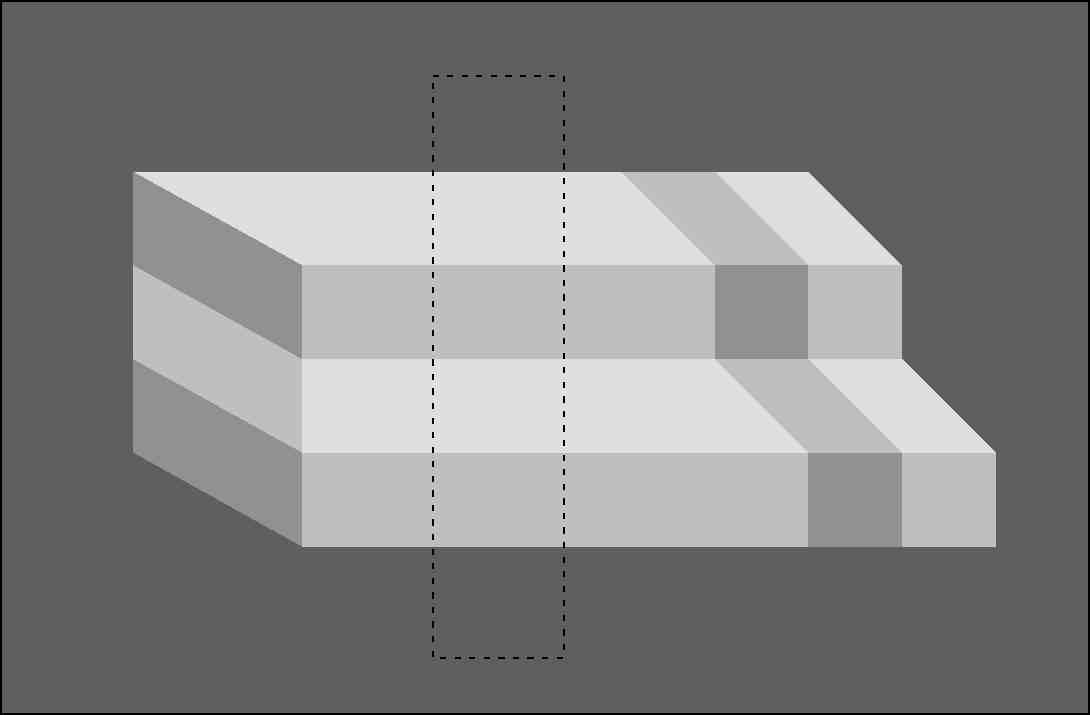
• X-junctions account for shifted Koffka rings
• T-junctions account for White’s illusion
- these illusions reveal the __________ made by the visual system about illumination and surfaces
According to Retinex theory, in general:
• gradations in luminance: attributed to variations in ____________ across the surface of an object
• abrupt luminance differences: attributed to differences in ___________ between different objects
How can these _______ ___________ be applied to edge detection in Marr’s approach?
Marr’s two-stage approach (1976):
1) raw primal sketch: detects edge segments
- representation of an image, such that intensity differences are made ________ (![]() global structures)
global structures)
- also, representations of __________ (features) and _____ ______ (their locations) are determined (![]() contours that may belong together)
contours that may belong together)
- ignores ______: doesn’t matter; likely is a separate system anyway (i.e., magno vs. parvo)
2) full primal sketch: represents higher-level boundaries
- boundaries and regions found by ________ primitive elements together
Problem: luminance at any point is not constant--it fluctuates imperceptibly (“______ _____”)
Solution: _______ intensity between a given spot and its neighbours (i.e., over a region of space)
What size region is chosen to average over?
• large region:
![]() get general shape
get general shape
![]() but lose ____ details
but lose ____ details
• small region:
![]() pick up lots of detail
pick up lots of detail
![]() but lose overall form
but lose overall form
Averaging process is like passing the image through a spatial ______:
• ___-____ filter (preserves gross features)
• band-pass filter (preserves intermediate details)
• ____-____ filter (preserves fine details)
To create the best raw primal sketch:
- obtain ________ representations in parallel
- each is a product of a different spatial filter
- result: get fine details, gross features, and everything in between
Marr & Hildreth’s (1980) algorithm:
1) smooth out small, unimportant variations that are due to differences in illumination
- take average around a given spot
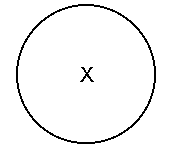
- but: the farther from the spot, the less informative the data
- so, apply a weighting function emphasizing the importance of the area at the centre while downplaying the contribution of regions farther away
- How? Use ________ (G ) function (“normal curve”):
G (x, y ) = exp ( |
_ x 2 + y 2 2πσ2 |
) |

• points closer to the centre have a greater weighting in the average
• at the periphery, points contribute the least
• to get different spatial filters, use different size Gaussian functions (measured by ________ _________)
2) extract ____ information from the representations
- an edge is defined as an abrupt change between a dark area and a light area--but how to detect this mathematically?
- _______________: rate of change of one variable with another
e.g. falling stone: differentiate distance vs. time
first derivative = ________
second derivative = ____________
- apply this differentiation transformation to filtered representations of the image
- e.g., differentiate intensity vs. space: an edge will produce a peak (or trough) in the first derivative, or a zero-crossing in the second derivative
- ____-________: function that crosses the baseline, produced by an edge
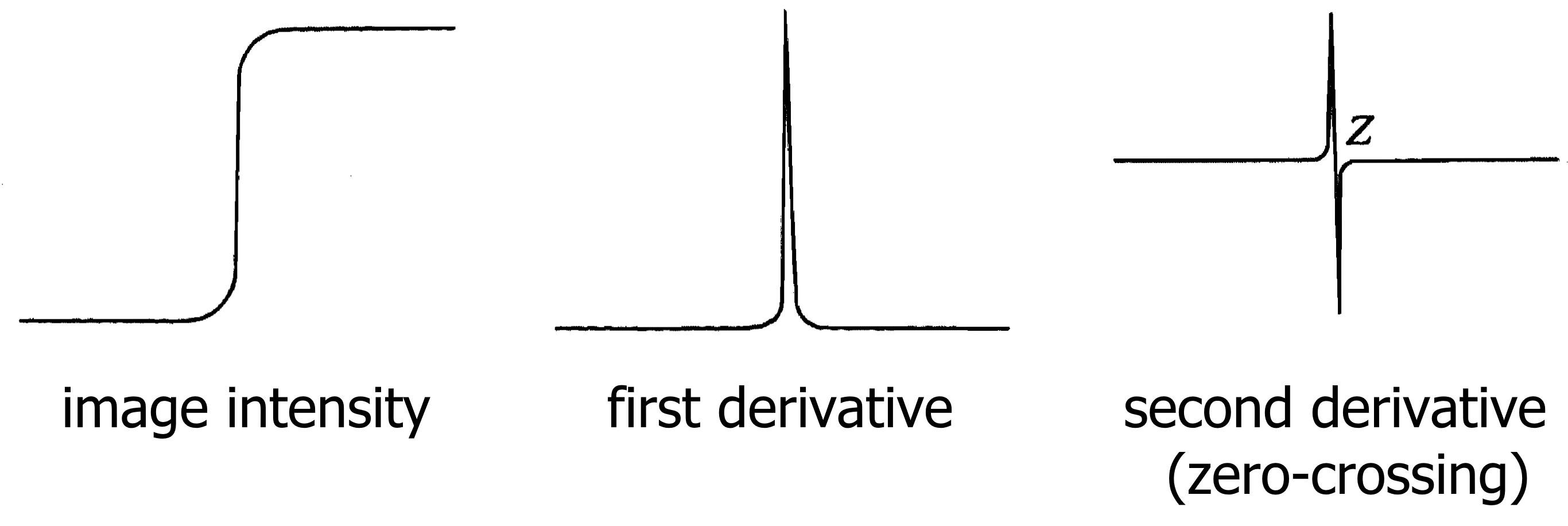
- obtain second differential over a two-dimensional area
- use a _________ operator (∇2), for all of the multiple representations:
∇2 |
= |
δ2 δx 2 |
+ | δ2 δy 2 |
- ∇2G is a band-pass filter
- repeat with different-sized filters
Result:
- ________ representations of the same input image--each one picks out variations of different spatial detail (or different intensities)
- raw primal sketch is comprised of the ___________ of all these representations--you don’t pick out the "best" one
- rationale: important boundaries should appear at multiple levels of detail
Combined how?
- match zero-crossings (borders) from representations filtered by similar ____ Gaussians
- this constructs several elements in the raw primal sketch, primitives:
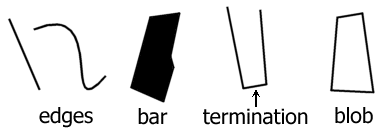
What is the output of the “raw primal sketch”?
• a representation of significant _________ of light intensity in a given image
How does the visual system do Laplacian transforms of Gaussian-filtered images (∇2G or LoG)?
- Gaussian filters: ______-________ receptive fields
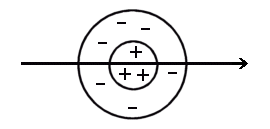
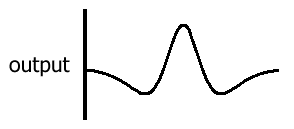
- this __________-of-Gaussian (DoG) approximates a Laplacian transform of a Gaussian filtered image:

According to feature template theory, a bar is detected by one simple cell, which receives connections from a number of similar-sized centre-surround receptive fields:
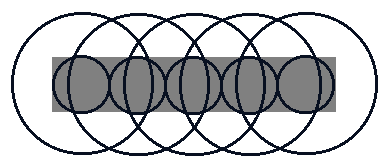
- this leads to ambiguity; it’s _____
Marr-Hildreth algorithm:


(circles represent centres of centre-surround receptive fields)
- feature detection depends on ____ detection
- an edge may be detected by taking the activity of _______ simple cells of differing sizes
- they must agree amongst themselves
- there must also be agreement between “light-side” (on-centre/off-surround) and “dark-side” (off-centre/on-surround) detector groups
Pros & Cons:
![]() supported by simulations/image processing
supported by simulations/image processing
![]() visual system has multiple spatial frequency ________
visual system has multiple spatial frequency ________
![]() Schiller (1982): turned off light-side detectors in monkeys, but still got sensitivity to ___________
Schiller (1982): turned off light-side detectors in monkeys, but still got sensitivity to ___________
![]() algorithm may generate “false edge,” especially at curved edges
algorithm may generate “false edge,” especially at curved edges
Other algorithms: Pearson & Robinson (1985):
- picked out “_______” in luminance separately from “_____”

- explains why ________ images are harder to identify
- maybe visual system operates on “_______” (e.g., black lines on white background), not simply zero-crossings/edges